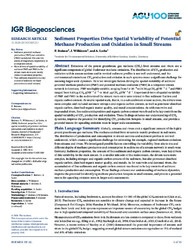Sediment Properties Drive Spatial Variability of Potential Methane Production and Oxidation in Small Streams
DOI: https://doi.org/10.1029/2019JG005213
Persistent URL: http://resolver.sub.uni-goettingen.de/purl?gldocs-11858/9372
Persistent URL: http://resolver.sub.uni-goettingen.de/purl?gldocs-11858/9372
Bodmer, P.; Wilkinson, J.; Lorke, A., 2020: Sediment Properties Drive Spatial Variability of Potential Methane Production and Oxidation in Small Streams. In: Journal of Geophysical Research: Biogeosciences, Band 125, 1, DOI: 10.1029/2019JG005213.
 |
Dokument öffnen: |
Emissions of the potent greenhouse gas methane (CH4) from streams and rivers are a significant component of global freshwater methane emissions. The distribution of CH4 production and oxidation within stream sections and in vertical sediment profiles is not well understood, and the environmental controls on CH4 production and emission in such systems create a significant challenge for assessing larger-scale dynamics. Here we investigate factors driving the spatial variability of sediment potential methane production (PMP) and potential methane oxidation (PMO) in a temperate stream network in Germany. PMP was highly variable, ranging from 5 × 10−4 to 28.58 μg CH4 gDW−1 d−1 and PMO ranged from 0.43 μg CH4 gDW−1 d−1 to 14.41 μg CH4 gDW−1 d−1. Important drivers of spatial variability of PMP and PMO in the sediments of the stream main-stem were related to fine sediment fraction and organic carbon content. At smaller spatial scale, that is, in a sub-catchment stream section, the drivers were more complex and included sediment nitrogen and organic carbon content, as well as porewater dissolved organic carbon, dissolved organic matter quality, and metal concentrations. As with reservoirs and impounded rivers, fine sediment deposition and organic carbon content were found to be key controls on the spatial variability of CH4 production and oxidation. These findings enhance our understanding of CH4 dynamics, improve the potential for identifying CH4 production hotspots in small streams, and provide a potential means for upscaling emission rates in larger-scale assessments.
Statistik:
ZugriffsstatistikSammlung:
This is an open access article under the terms of the Creative Commons Attribution License, which permits use, distribution and reproduction in any medium, provided the original work is properly cited.

